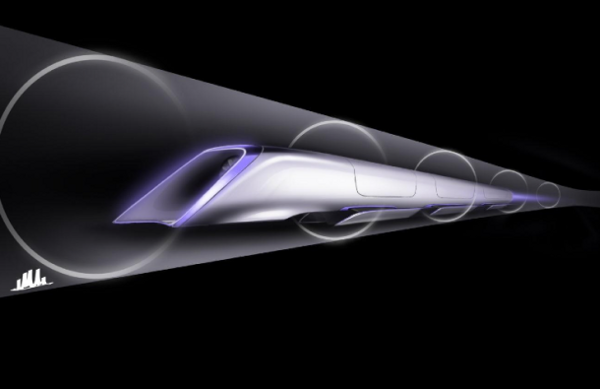
If money is power, then Elon Musk is a powerful man. The director of Iron Man even said he even based Tony Stark’s playboy persona on Musk.
The entrepreneur is the founder behind giants SpaceX, Tesla and PayPal, and has this week given us at outline of his new multi-billion dollar vision: Hyperloop.
But is it a vision that’s on the right tracks or is it just a load of hot air?

An artists impression of a pod as shown in Musk’s outline of the project.
What is Hyperloop?
Billionaire Elon Musk has proposed a new method of transport using magnets and fans to propel a pod, similar to a train carriage, along a tube connecting the cities of Los Angeles and San Francisco. The pods, or capsules, would be floating on a cushion of air and make the journey between the two Californian cities in just 30 minutes. That works out to mean traveling at over 600mph to make the 350 mile journey in that hoped half-hour travel time.
"Both for trip comfort and safety, it would be best to travel and high subsonic speeds for a 350 mile journey," says Musk.
On top of these grand visions, Musk says the transport system would be solar powered, meaning a safer, less costly and more efficient mode of transport.
So how does it work?
Musk is saying that the pod would travel along a tube held up by pylons running parallel to existing rail tracks and freeways, cutting down on the need for land permission. To make something go as fast as he is proposing, it is much easier if there is no air resistance for the pod to fight against in that tube, so a further twist in the plan is that the tube would work better if a vacuum. No small feat…
"The problem with this approach is that it is incredibly hard to maintain a near vacuum in a room, let alone 700 miles (round trip) of a large tube with dozens of station gateways and thousands of pods entering and exiting every day."
A better solution would be to have a very low pressure of air in the tube.
With that being the case, Musk suggests mounting an electric compressor fan on the nose of the pod that transfers high pressure from the front to the rear, allowing the pod to use a cushion of air as a low-friction suspension system.
"Just as aircraft climb to high altitudes to travel through less dense air, Hyperloop encloses the capsules in a reduce pressure tube.
"It would be equivalent to traveling above 150,000 feet altitude."

Loopy?
Musk said in his Hyperloop Alpha paper, outlining his plans, that he was disappointed when the California "high speed" rail was approved.
"How could it be that the home of Silicon Valley – doing incredible things like indexing the world’s knowledge and putting rovers on Mars – would build a bullet train that is both one of the most expensive per mile and one of the slowest in the world?"
He goes on to say that "The Hyperloop is, in my opinion, the right solution for the specific case of high traffic city pairs that are less than about 900 miles apart."
What is really interesting about Hyperloop is that Musk himself has said he doesn’t have time to see the estimated $6bn project through. Hyperloop is ‘open-source’.
"Feedback is desired from the community that can help advance the Hyperloop design and bring it from concept to reality."
Usually this means that something like Hyperloop would be just hyped-up hot air. He’s just teasing people with his grand designs, but not prepared to carry it out. However, Musk has admitted he is prepared to build a ‘subscale’ demonstrator.
But again, the prototype would have to wait as Musk is currently very busy with his commercial space project SpaceX. A demonstration model would take up to four years to complete, he said. But not everyone is accepting the legitimacy of Musk’s plans.
"The fastest maglev speed recorded is 361mph, well short of the 900mph this tube idea would require," wrote bullet train advocate Robert Cruickshank on the California High Speed Rail Blog.
"Supersonic aerial transport has been tried, namely with the Concorde, but the operating costs were too high and it proved to be extremely difficult to get permission to operate it over land (which is why it primarily served a trans-atlantic route).
"I’m not trying to harsh on Elon Musk’s idea, but this is not particularly realistic," added Cruickshank.
"Sure, there’s been a lot of technological innovation over the last 20 years, but it’s led to the iPhone, not a series of transportation tubes."

A business revolution?
With the advent of the unparalleled speed of the internet, the need for supersonic travel died. Why would businesses spend thousands of pounds flying across the Atlantic on Concorde when you can have a meeting over the net.
With both high subsonic and perhaps supersonic land travel, would this start a new age where face-to-face meetings are economically and physically viable again from across continents? And would systems such as Hyperloop or similar be the start of a new kind of tourism? Holidays would be more economically accessible and Hyperloop would grant the ability to be at the destination for a longer amount of time.
It’s still too early on to judge how the Hyperloop vision is being deemed by experts around the world, and it will be interesting to hear feedback from critics and backers alike. If Hyperloop can be anything like Musk’s SpaceX though, we will sure see a strong contender for super-fast travel, because when Musk says something, he usually really means it.






